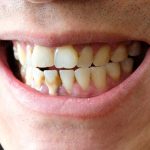Why Are My Gums Separating From My Molars?
Gums separating from teeth or receding gums can be called gingival recession too. It happens when the margin of the gums moves upward and results in the exposure of the upper part of the tooth known as the “root”. This results in teeth separating from the gums. Separated teeth, if left untreated can lead to a number of significant dental health issues. Sometimes, teeth separating can also result in gum diseases known as “Periodontal Diseases”.
Receding gums or separated teeth occur when the gingival tissue encircling the teeth becomes too feeble and withdraws from the molars ultimately revealing the roots of the teeth. Gums separating from teeth or gum recession is a very widespread problem due to the multiple factors associated with the posture and role of molars in the mouth.
What causes gums to separate from teeth?
- Forceful Brushing:
Using too old toothbrushes or brush with very hard bristles often leads to the injury of the soft and tender gingival tissue. This increases the chances of gum recession leading to teeth separating from gums.
- Teeth Clenching Issues (Bruxism):
Unintentional or intentional teeth clenching and grinding exerts useless and extreme pressure upon the gums of the teeth particularly of the molars. This can also lead to separated teeth.
- Genetic Factors:
Some people might be susceptible to receding gums or gums separating from teeth due to some genetic factors too. A variety of hereditary factors affect the stoutness and endurance of the gingival tissues too.
- Imperfect Dental Hygiene:
Unsatisfactory flossing and brushing techniques permits the bacteria and food debris to accumulate leading to plaque which mineralize to form tartar. The tartar encircles the margin of the gum and causes severe swelling. As a consequence, the gums bleed and results in teeth separating.
- Displaced teeth:
Displacement of teeth from their original position is referred to as “Malocclusion”. It can give rise to regions of outrageous force while chewing food, ultimately leading to gums separating from teeth.
- Periodontal Diseases:
Receding gums are most commonly caused due to periodontal disease, a bacterial infestation that harms the gingival tissue and substratum bone. As the problem intensifies, it can lead to gums separating from teeth (gum recession).
- Hormonal Imbalance:
Instability in the hormonal levels during periods of pregnancy, puberty and menopause can influence the health of the gums. It can also lead to teeth separating from gums in some individuals.

What happens when your gums separate from your teeth?
Sensitivity in The Teeth:
If teeth separating from the gums occur, the teeth may become sensitive to hot and cold, too much sour and sweet stuff as the roots of the teeth are fully exposed.
Bleeding Gums:
Aggressive brushing and forceful flossing can cause the gums to become tender leading them to bleed excessively.
Exposed Roots:
Due to gums separating from teeth, the roots of the teeth are uncovered which provokes dreadful pain. This is the biggest sign of the gum recession.
Tooth Decay:
Roots of the teeth are very sensitive and they don’t have the same hard covering called “Enamel”, just like the crown. Exposed roots are very much susceptible to bacterial attacks and cavities and can often trigger tooth decay if left untreated.
Bad Breath (Halitosis):
Separated teeth from gums or gum recession can often lead to reduced saliva production in the oral cavity. Saliva plays a crucial role in washing away the unwanted food debris and bacteria. Lack of secretion of the saliva from the salivary glands makes the mouth exceedingly dry, which aggravates halitosis.
How to fix gums separating from teeth?
Maintenance of Good Oral Health:
Brushing teeth thrice or at least twice a day with a good quality toothpaste, flossing properly and using mouthwash can prevent the teeth separating from gums.
Advanced Cleaning Procedures:
Professional and advanced cleaning procedures such as scaling etc can prevent the accumulation of plaque and tartar. This can reduce the risk of teeth separation from gums.
Proper Dental Examinations:
Early detection of certain dental problems by routine check-ups at the dentist reduces the risk of gum recession and other issues. Dentists use professional and proven methods to identify the root cause of gum recession and address the complications accordingly.
Orthodontic Treatment:
Confronting problems like misalignment of teeth can help to resolve the problem of pressure distribution throughout all the molars equally. This helps to prevent the teeth separating from gums.
Role of Separators teeth:
The function of separators teeth in receding gums is very scant and subtle. Separators teeth, also known as dental spacers, are tiny, flexible, soft, elastic and metal hoops. They are arranged between the junctions of the teeth. This placement creates a space which becomes useful for orthodontic bands.
Normally, separators teeth are used as an introductory phase in certain orthodontic treatment to aid the allocation of braces.
Although, separators teeth themselves don’t lead to teeth separating from gums at all. But in case they are placed in a wrong or irregular position, severe gum swelling and redness can take place. This condition can even worsen if the patient was previously facing additional oral health issues. If left untreated, risk of tooth decay can be increased.
It’s vital to remember that receding gums fundamentally occur due to certain periodontal disease, forceful flossing and brushing, hereditary factors or some sort of distress instead of the presence of separators teeth. Nonetheless, if a patient is treated with dental separators then it is important to monitor the changes on and off in order to avoid possible unpleasant effects on the gingival tissues.
Gum separation is often a common cause and has a lot of adverse effects. In case you have more questions regarding it, we would highly suggest you to visit our website ivanovortho.com and book your appointment today. We’ll try our best to resolve your issue so you always smile bright like a diamond.



